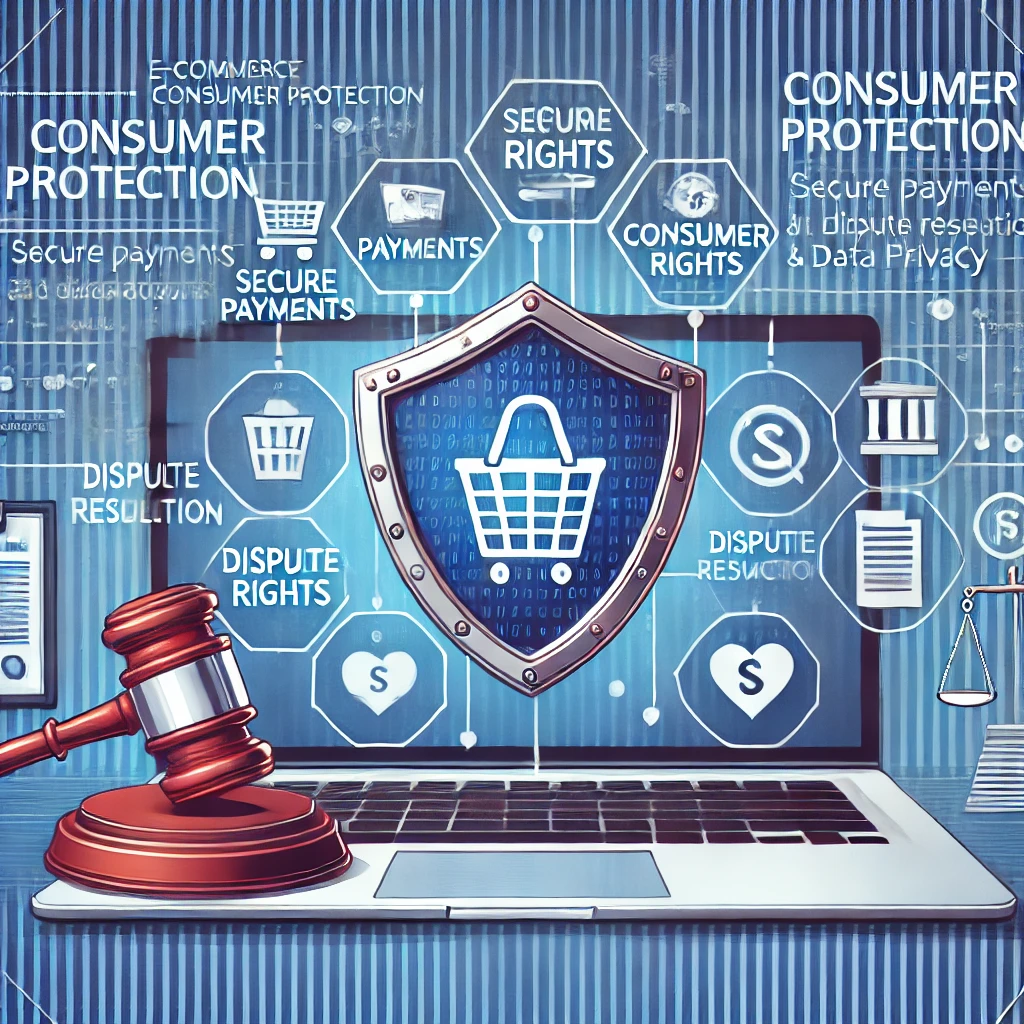
Victoriya is a third-year BA LLB student at Government Law College, Vellore, affiliated with Tamil Nadu Dr. Ambedkar Law University, Chennai, Read More.

Abstract:
The rapid – fire growth of e-commerce in India has converted the way consumers shop and interact with businesses. Still, this growth has also raised enterprises about consumer protection. To address these enterprises, the Indian government has established a nonsupervisory frame that safeguards consumers’ rights and interests. This paper examines the part of e-commerce regulations under the Consumer Protection Act, 2019, and the Consumer Protection (E-commerce) Rules, 2020. The study provides an in – depth analysis of the crucial vittles, impacts, and challenges of these regulations.
It highlights the significance of translucency, responsibility, and consumer protection in the e-commerce ecosystem. The paper also discusses the challenges faced by small and medium – sized enterprises in complying with nonsupervisory vittles and the need for ongoing sweats to balance invention with consumer protection. The study aims to give a comprehensive understanding of the nonsupervisory frame governing e-commerce in India and its counteraccusations for consumers, businesses, and the overall e-commerce ecosystem.
Key words: Consumer Protection, E-commerce, Fall-back liability, Consumerism, Safeguards
Introduction:
The arrival of e-commerce has revolutionized the way consumers shop and interact with businesses in India. Still, this rapid-fire growth has also raised enterprises about consumer protection. To address these enterprises, the Indian government has established a non supervisory frame that safeguards consumers’ rights and interests. This frame has its roots in the Consumer Protection Act of 1986, which was legislated to give better protection to consumers. Over time, the Act has experienced significant amendments, including the Consumer Protection Act of 2019, to keep pace with the changing request dynamics and the rise of e-commerce.
The growth of e-commerce in India has been phenomenal, with the sector anticipated to reach $ 200 billion by 2025. This growth has been driven by adding internet penetration, growing smartphone operation, and favorable demographics. Still, the rise of e-commerce has also led to new challenges, similar to fake reviews, fake products, and data sequestration enterprises. To address these challenges, the Indian government has introduced colorful regulations, including the Consumer Protection (E-Commerce) Rules of 2020.
This paper seeks to explore the role of e-commerce regulations under consumer protection in India, tracing the history of consumer protection in the country and examining the elaboration of e-commerce regulations. It’ll claw into the crucial vittles of the Consumer Protection Act and the rules governing e-commerce, pressing their impact on consumers, businesses, and the overall e-commerce ecosystem in India.
Legal Frameworks:
The Consumer Protection Act was first introduced in India in 1986 and has been amended several times. In 2019, the new Kanji Consumer Protection Act was introduced to replace this Act. The main consumer rights and responsibilities mentioned in them are as follows:
Section 2 (9)
- Any person who purchases goods or services for his own use is a customer.
- A person who purchases goods or services for business use and uses such goods or services for his own use is considered a customer[1].
Section 94
- Unfair commercial practices shall not be used in advertising, using or distributing goods or services.
- Advertising images taken with the intention of misleading customers fall under unfair commercial practices[2].
Section 100 – A
- In case of injury to a customer due to defects in goods or services, the manufacturer or service provider shall be liable[3].
- The manufacturer of a food product, such as a food coloring, should be held fully liable for any damages caused to the consumer due to a defect in the food product[4].
Section 101(6)
- Right to object to the marketing of dangerous products or services
- Right to know the quality, weight, cleanliness, etc. of the product or service being used
- Right to choose and use the product or service
- Right to claim compensation for mis leading commercial practices or defective products and services.
- Right to awareness of consumer rights and obligations[5].
E-commerce Regulations:
Pursuant to the Consumer Protection Act, 2019 the Consumer Protection (E-commerce) Rules 2020 were introduced to oversee e-commerce activities and protect consumer interests. These rules specify the duties and arrears of e-commerce realities and merchandisers on their platforms.
Rule 3:
E-commerce realities must ensure that the goods or services handed are authentic and match the description.
Amazon Seller Services Pvt. Ltd. v. Amway India Enterprises Pvt. Ltd. (2020)
- Fact : Amway contended that Amazon was dealing fake Amway products on its platform.
- Issue: Is that authentication of products a duty for e-commerce entities?
- Judgment: The court held that Amazon, as an e-commerce reality, had a duty to insure that the products vended on its platform were authentic[6].
Rule 4:
E-commerce realities are banned from engaging in illegal trade practices, including making false or deceiving statements.
Flipkart Internet Pvt. Ltd. v. Ashmita (2019)
- Fact: Ashmita contended that Flipkart had made false claims about a product’s quality and features.
- Issue: Is false claims of products an illegal trade practice ?
- Judgment : The court held that Flipkart had engaged in an illegal trade practice and directed it to refund the quantum paid by Ashmita[7].
Rule 5:
E-commerce realities must appoint a Grievance Officer to address consumer complaints.
Paytm Boardwalk v. Mohit (2020)
- Fact: Mohit contended that Paytm Mall had failed to address his complaint about an imperfect product.
- Issue: Is Paytm’s fault for non compliance of rule 5 ?
- Judgment: The court held that Paytm Mall had failed to misbehave with Rule 5 and directed it to appoint a Grievance Officer[8].
Rule 6:
E-commerce realities must expose the country of origin of goods and give a sludge medium on their website grounded on the country of origin.
Xiaomi Technology India Pvt. Ltd. v. Ministry of Commerce and Industry (2020)
- Fact: Xiaomi contended that the Ministry’s demand to expose the country of origin.
- Issue: Whether demand for disclosure of manufacturing facts was arbitrary?
- Judgment: The court held that the demand was reasonable and directed Xiaomi to misbehave with Rule 6[9].
Rule 7:
E-commerce realities are banned from organizing flash deals.
All India Online merchandisers Association v. Flipkart Internet Pvt. Ltd. (2020)
- Fact: The Association contended that Flipkart’s flash deals were illegal and discriminative.
- Issue: Whether Flipkart’s flash deals violate rule 7 or not ?
- Judgment: The court held that Flipkart’s flash deals violated Rule 7 and directed it to cease similar practices[10].
Rule 8:
E-commerce realities are confined from engaging incross-selling and mis- dealing practices.
Amazon Seller Services Pvt. Ltd. v. Rohan (2020)
- Fact: Rohan contended that Amazon had engaged incross-selling and mis- dealing practices.
- Issue: Is that Amazon’s behaviour engaged against rule 8 ?
- Judgment: The court held that Amazon had violated Rule 8 and directed it to refund the quantum paid by Rohan[11].
Rule 9:
E-commerce realities must n’t allow deceiving announcements on their platforms.
Flipkart Internet Pvt. Ltd. v. Ministry of Consumer Affairs (2020)
- Fact Issue: Flipkart contended that the Ministry’s guidelines on misleading announcements were vague.
- Judgment: The court held that the guidelines were reasonable and directed Flipkart to misbehave with Rule 9[12].
Impacts of E-commerce Regulations:
- Transparency between the seller and the customer has increased.
- Increased accountability of online sellers.
- Increased protection against unfair business practices.
- Improved grievance redressal mechanisms for customers buying goods online.
- Fair competition prevails in online commerce.
- Increased customer confidence in online commerce.
- Improved regulations and regulations have increased e-commerce revenue.
- Increased e-commerce has
- Provided remote employment opportunities for many people.
- Increased gross domestic product.
- Increased tax collection.
Challenges of E-commerce Regulations:
- Small and medium-sized enterprises do not have sufficient resources to comply with the provisions of this Act.
- It is worth considering which court jurisdiction online transactions fall under.
- The process of resolving disputes between sellers and customers in online transactions is time-consuming and costly.
- Many customers are not aware of their online transaction rights and responsibilities.
- Protecting customer data is a major issue in online transactions.
- Since different states follow different laws, it is questionable which state law will apply to online transaction issues.
Conclusion:
The non – supervisory frame governing e-commerce in India plays a vital part in securing consumer rights and promoting fair trade practices. The Consumer Protection Act, 2019, and the Consumer Protection (E-commerce) Rules, 2020, give a robust frame for regulating e-commerce conditioning.
These regulations have had a positive impact on translucency, responsibility, and consumer protection. The Consumer Protection Act, 2019, has introduced significant vittles, similar as the establishment of the Central Consumer Protection Authority (CCPA), which has the power to probe and discipline violators.
Still, challenges persist, particularly for small and medium- sized enterprises( SMEs) that face difficulties in complying with nonsupervisory conditions. To address these challenges, ongoing sweats are demanded to support SMEs and ensure they can misbehave with regulations.
Controllers must also continue to evolve and acclimatize to the changing e-commerce geography. This requires ongoing monitoring and review of the non supervisory frame, as well as collaboration with stakeholders.
In conclusion, thenon-supervisory frame governing e-commerce in India is critical for securing consumer rights and promoting fair trade practices. While challenges persist, the nonsupervisory frame has had a positive impact. Ongoing sweats are demanded to support SMEs, evolve the nonsupervisory frame, and promote collaboration among stakeholders to ensure a thriving e-commerce ecosystem. This requires a sustained commitment to guarding consumer rights and promoting fair trade practices.
Bibliography
https://ncdrc.nic.in/bare_acts/CPA2019.pdf
[1] Laxmi Engineering Works v. P.S.G. Industrial Institute (1995) 3 SCC 583
[2] Colgate-Palmolive (India) Ltd. v. Hindustan Lever Ltd. (1997) 3 SCC 1
[3] The Consumer Protection Act, 2019, (Act no. 35) §2 (9) & §94 & §100A
[4] Ajinomoto Sweeteners India Pvt. Ltd. v. State of Gujarat (2007) 2 SCC 503
[5] The Consumer Protection Act, 2019, (Act no. 35) §101 (6)
[6] Amazon Seller Services Pvt. ltd vs. Amway India Enterprises Pvt. Ltd. (2020) 2 SCC 674
[7] Flipkart Internet Pvt. Ltd. v. Ashmita (2019) 5 SCC 354
[8] Paytm Mall v. Mohit (2020) SCC OnLine Del 790
[9] Xiaomi Technology India Pvt. Ltd. v. Ministry of Commerce & Industry (2020) SCC OnLine Del 1066
[10] All India Online Vendors Association v. Flipkart Internet Pvt. Ltd. (2020) SCC OnLine Del 1454
[11] Amazon Seller Services Pvt. Ltd. v. Rohan (2020) SCC OnLine Del 1721
[12] Flipkart Internet Pvt. Ltd. v. Ministry of Consumer Affairs (2020) SCC OnLine Del 1934






